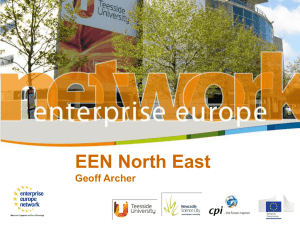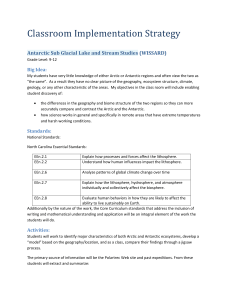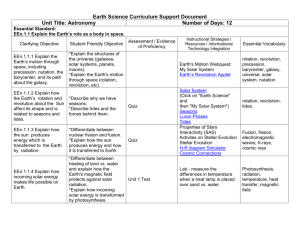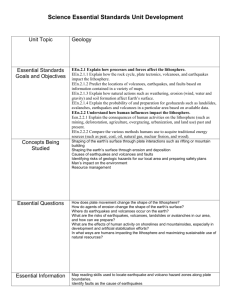Ms.Mechalske's Outline
advertisement
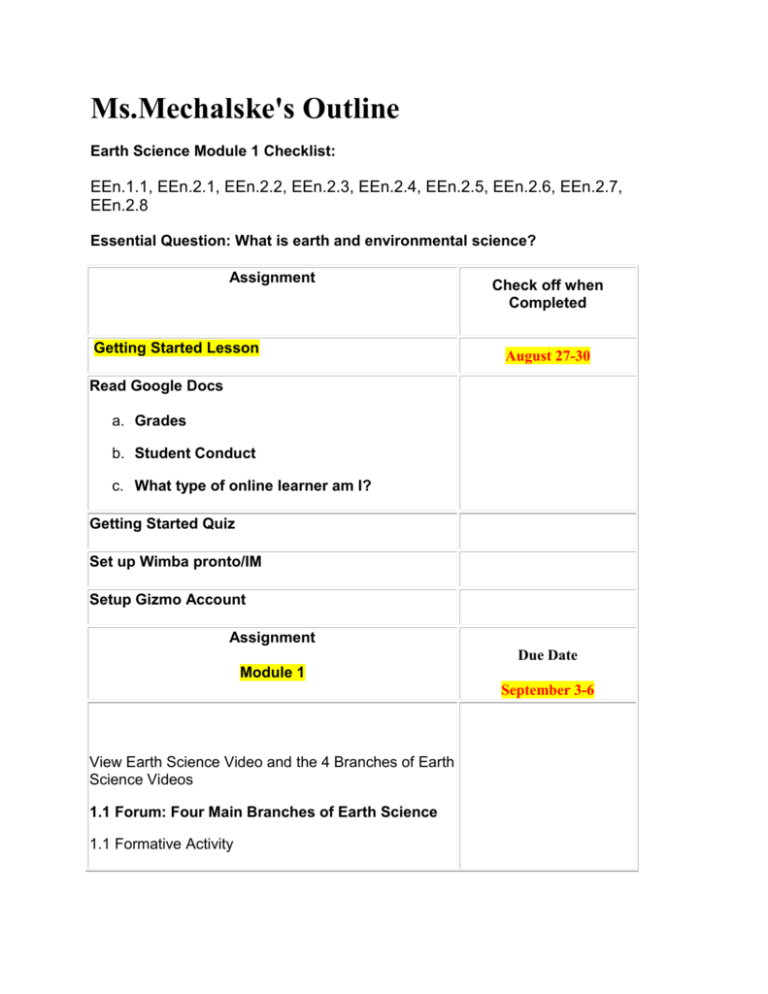
Ms.Mechalske's Outline Earth Science Module 1 Checklist: EEn.1.1, EEn.2.1, EEn.2.2, EEn.2.3, EEn.2.4, EEn.2.5, EEn.2.6, EEn.2.7, EEn.2.8 Essential Question: What is earth and environmental science? Assignment Getting Started Lesson Check off when Completed August 27-30 Read Google Docs a. Grades b. Student Conduct c. What type of online learner am I? Getting Started Quiz Set up Wimba pronto/IM Setup Gizmo Account Assignment Due Date Module 1 September 3-6 View Earth Science Video and the 4 Branches of Earth Science Videos 1.1 Forum: Four Main Branches of Earth Science 1.1 Formative Activity 1.2 Graphic Organizer Scientific Method Presentation Scientific Method Flash Cards Scientific Method Video Formative Assessment – Order of Scientific Method 1.3 Study Guide 1.4 Gizmo – Effect of the environment on a new life form 1.5 Assessment 1.7 Honors – Scientific Method Earth Science Module 2 Checklist: 2.2.1: Explain the consequences of human activities on the lithosphere (such as mining, deforestation, agriculture, overgrazing, urbanization, and land use) past and present. 2.2.2: Compare the various methods humans use to acquire traditional energy sources (such as peat, coal, oil, natural gas, nuclear fission, and wood). 2.7.3: Explain how human activities impact the biosphere. 2.8.1: Evaluate alternative energy technologies for use in North Carolina. 2.8.2: Critique conventional and sustainable agriculture and aquaculture practices in terms of their environmental impacts 2.8.4: Evaluate the concept of “reduce, reuse, recycle” in terms of impact on natural resources. Essential Question: What is the human impact on the lithosphere? Assignment Completed MODULE 2 September 9-13 2.1 Lecture & Study Guide Formative Assessment 2.2 Soil Webquest 2.3 Gizmo: Household Energy Use 2.4 Columbia River Debate 2.5 Assessment 2.7 Honors - Timeline Earth Science Module 3 Checklist: 2.1.1 Explain how the rock cycle, plate tectonics, volcanoes, and earthquakes impact the lithosphere. 2.1.2 Predict the locations of volcanoes, earthquakes, and faults based on the information contained in a variety of maps. 2.1.3 Explain how natural actions such as weathering, erosion, and soil formation affect Earth's surface. 2.2.1 Explain the consequences of human activities on the lithosphere. Essential Question: What are the processes that shape the lithosphere? Assignment Module 3 3.1 Lecture & Study Guide Formative Assessment 3.2 Geohazard / Land Form Glogster 3.3 Gizmo: The Rock Cycle 3.4 Forum: The Dust Bowl 3.5 Assessment 3.7 Honors – Writing Assignment Completed September 16-20 Earth Science Module 4 Checklist: 2.1.1 Explain how the rock cycle, plate tectonics, volcanoes, and earthquakes impact the lithosphere. 2.1.2 Predict the locations of volcanoes, earthquakes, and faults based on information contained in a variety of maps. 2.1.4 Explain the probability of and preparation for geohazards such as landslides, avalanches, earthquakes and volcanoes in a particular area based on available data. Essential Question: What are the effects of the earth’s plates moving? Assignment Module 4 4.1 Lecture Plate Tectonic Vocabulary Plate Tectonic Overview Video Plate Tectonic Interactive Activity Formative Assessment 4.1 Tracking Plate Movement Earthquake Power point Earthquake Podcast Interactive Earthquake Activity Completed September 23-27 4.2 Earthquake Predictions Volcano Power point Volcano Podcast Interactive Volcano Activity Interactive Volcano Lesson 4.3 Volcano Comparison Mountain Building Notes Mountain Building Video Mountain Building Review Formative Assessment 4.4 Grandfather Mountain Quiz 4.5 Assessment 4.7 Honors – Adopt a volcano Earth Science Module 5 Checklist: 2.2.1: Explain the consequences of human activities on the lithosphere (such as mining, deforestation, agriculture, overgrazing, urbanization, and land use) past and present 2.2.2: Compare the various methods humans use to acquire traditional energy sources (such as peat, coal, oil, natural gas, nuclear fission, and wood). 2.6.3: Analyze the impacts that human activities have on global climate change (such as burning hydrocarbons, greenhouse effect, and deforestation). 2.7.3: Explain how human activities impact the biosphere. 2.8.1: Evaluate alternative energy technologies for use in North Carolina 2.8.4: Evaluate the concept of “reduce, reuse, recycle” in terms of impact on natural resources. Essential Question: What are non-renewable energy resources? Assignment Module 5 5.1 Lecture & Study Guide Video: Are fossil fuels running out? Formative Review 5.2 Create a voki Completed September 30October 4 5.3 Gizmo: Energy Conversions 5.4 Energy Webquest 5.5 Assessment 5.7 Honors – Energy Pros and Cons Earth Science Module 6 Checklist: 2.2.1 Explain the consequences of human activites on the lithosphere. 2.6.3 Analyze the the impacts that human activities have on global climate change. 2.7.3 Explain how human activities impact the biosphere. 2.8.1 Evaluate alternative energy technologies for use in North Carolina. 2.8.4 Evaluate the concept of "reduce, reuse, recycle" in terms of impact on natural resources. Essential Question: What are renewable energy resources? Assignment Completed Module 6 October 7-11 6.1 Lecture & Study Guide Formative Assessment – Matching Game 6.2 Lab Choice – Pick one of three lab options to complete 6.3 Forum: Ten ways you can reduce your use of fossil fuels 6.4 Forum: Alternative Energy 6.5 Assessment 6.7 Honors – Wind Study Earth Science Module 7 Checklist: 2.1.1 Explain how the rock cycle, plate tectonics, volcanoes, and earthquakes impact the lithosphere. 2.1.2 Predict the locations of volcanoes, earthquakes, and faults based on information contained in a variety of maps. 2.7.2 Explain why biodiversity is important to the biosphere. 2.6.4 Attribute changes in Earth systems to global climate change (temperature change, changes in pH of ocean, sea level changes, etc.). Essential Question: What are some geologic events in NC history? Assignment Module 7 7.1 Lecture & Study Guide Video: A glimpse of the earth’s past 7.2 NC Geologic History Scramble 7.3 NC Geologic History Scavenger Hunt Completed October 14-18 7.4 Gizmo: Half-life 7.5 Assessment 7.7 Honors – Forum: Mass Extinction Earth Science Module 8 Checklist: EEn.1.1, EEn.2.1, EEn.2.2, EEn.2.3, EEn.2.4, EEn.2.5, EEn.2.6, EEn.2.7, EEn.2.8 Essential Question: What are main points of the first half of the Earth Science course? Assignment Module 8 8.1 Lecture & Study Guide 8.2 Midterm Project 8.3 Midterm review of resources 8.4 Formative Exam Review 8.5 Midterm 8.7 Honors – Creating a volcano Completed October 21-25 Earth Science Module 9 Checklist: 2.1.1 Explain how Earth's processes impact the lithosphere. 2.1.3 Explain how natural actions such as wave erosion affect the Earth's surface. 2.4.1 Evaluate human influences on freshwater availability. 2.4.2 Evaluate human influences on water quality in North Carolina. 2.6.4 Attribute changes to Earth's systems to global climate change. 2.7.3 Explain how human activities impact the biosphere. Essential Question: What are some impacts of beach erosion? Assignment Module 9 Completed October 28November 1 9.1 Lecture & Study Guide Formative Assessment 9.2 Shell Island Dilemma 9.3 Oceans Overview Video Lab 9.4 Upwelling Lab Choice – Choose between 2 labs to complete this assignment 9.5 Forum: Coastlines 9.6 Assessment 9.7 Honors – Gizmo: Coastal Winds and Clouds Earth Science Module 10 Checklist: 2.3.2 Explain how ground water and surface water interact. 2.4.1 Evaluate human influences on freshwater availability. 2.4.2 Evaluate human influences on water quality in North Carolina’s river basins, wetlands and tidal environments. Essential Question: What is the water cycle? Assignment Module 10 10.1 Lecture & Study Guide 10.2 Gizmo: Water Cycle Completed November 4-8 10.3 NC Estuaries 10.4 Forum: Water Conservation 10.5 Assessment 10.7 Honors – Where does the rain go? Earth Science Module 11 Checklist: 2.5.1 Summarize the structure and composition of our atmosphere. 2.5.2 Explain the formation of typical air masses and the weather systems that result from air mass interactions. 2.5.3 Explain how cyclonic storms form based on the interaction of air masses. Essential Question: What processes in the atmosphere effect weather? Assignment Module 11 Completed November 11-15 11.1 Lecture & Study Guide Formative Assessment 11.2 Gizmo: Hurricane Motion 11.3 Concept Map 11.4 Weather Webquest 11.5 Assessment 11.7 Honors – Identify clouds Earth Science Module 12 Checklist: 2.6.1: Differentiate between weather and climate. 2.7.1: Explain how abiotic and biotic factors interact to create the various biomes in North Carolina. 2.7.2: Explain why biodiversity is in important to the biosphere. Essential Question: What is the difference between weather and climate? Assignment Completed Module 12 November 18-22 12.1 Lecture & Study Guide Formative Assessment 12.2 Overview of Biomes Chart 12.3 Forum: Protecting Biodiversity in NC 12.4 Invasive Species Lab 12.5 Assessment 12.7 Honors – Climate Webquest Earth Science Module 13 Checklist: 2.5.5 Explain how human activities affect air quality. 2.6.1 Differentiate between weather and climate. 2.6.2 Explain changes in global climate due to natural processes. 2.6.3 Analyze the impacts that human activities have on global climate change (such as burning hydrocarbons, greenhouse effect, and deforestation). 2.6.4 Attribute changes in Earth systems to global climate change (temperature change, changes in pH of ocean, sea level changes, etc.). Essential Question: What are the effects of air pollution? Assignment Module 13 Completed November 25-27 13.1 Lecture & Study Guide Formative Assessment 13.2 Air Pollution and Global Change Choice 13.3 Air Pollution & Global Change Forum 13.4 Air Pollution & Solutions Video Quiz 13.5 Assessment 13.7 Honors – Air Pollution Poster Earth Science Module 14 Checklist: 2.5.4 Predict the weather using available weather maps and data (including surface, upper atmospheric winds, and satellite imagery). Essential Question: How do you predict the weather? Assignment Module 14 Completed December 2-6 14.1 Lecture & Study Guide Formative Assessment 14.2 NOAA Weather and NC 14.3 Gizmo: Weather Maps 14.4 Weather Forecast 14.5 Assessment 14.7 Honors – NOAA Satelites Earth Science Module 15 Checklist: 1.1.1 Explain the Earth's motion through space, including precession, nutation, the barycenter, and its path about the galaxy. 1.1.2 Explain how the Earth's rotation and revolution about the Sun affect its shape and is related to seasons and tides. Essential Question: What are some facts about planetary motion? Assignment Module 15 Completed December 9-13 15.1 Lecture & Study Guide Formative Game Play 15.2 Collaborative Forum 15.3 Venn Diagram 15.4 Planetary Motion Lab 15.5 Assessment 15.7 Honors – Earth Travel Brochure Earth Science Module 16 Checklist: 1.1.3 Explain how the sun produces energy which is transferred to the Earth by radiation. 1.1.4 Explain how incoming solar energy makes life possible on Earth. Essential Question: What are the effects of the sun on you? Assignment Module 16 Completed December 16-20 16.1 Study Guide 16.1 Formative Assessment 16.2 Gizmo: Why do we have seasons? 16.3 Solar Activity 16.4 Forum: Life without the sun 16.5 Assessment 16.7 Honors – Nuclear Fusion Press Release Earth Science Module 17 Checklist: 1.1.1 Explain the Earth’s motion through space, including precession, nutation, the barycenter, and its path about the galaxy. 1.1.2 Explain how the Earth’s rotation and revolution about the Sun affect its shape and is related to seasons and tides. 1.1.3 Explain how the sun produces energy which is transferred to the Earth by radiation. 1.1.4 Explain how incoming solar energy makes life possible on Earth. 2.1.1 Explain how the rock cycle, plate tectonics, volcanoes, and earthquakes impact the lithosphere. 2.1.2 Predict the locations of volcanoes, earthquakes, and faults based on information contained in a variety of maps. 2.1.3 Explain how natural actions such as weathering, erosion (wind, water and gravity), and soil formation affect Earth’s surface. 2.1.4 Explain the probability of and preparation for geohazards such as landslides, avalanches, earthquakes and volcanoes in a particular area based on available data. 2.2.1 Explain the consequences of human activities on the lithosphere (such as mining, deforestation, agriculture, overgrazing, urbanization, and land use) past and present. 2.2.2 Compare the various methods humans use to acquire traditional energy sources (such as peat, coal, oil, natural gas, nuclear fission, and wood). 2.3.1 Explain how water is an energy agent (currents and heat transfer). 2.3.2 Explain how ground water and surface water interact. 2.4.1 Evaluate human influences on freshwater availability. 2.4.2 Evaluate human influences on water quality in North Carolina’s river basins, wetlands and tidal environments. 2.5.1 Summarize the structure and composition of our atmosphere. 2.5.2 Explain the formation of typical air masses and the weather systems that result from air mass interactions. 2.5.3 Explain how cyclonic storms form based on the interaction of air masses. 2.5.4 Predict the weather using available weather maps and data(including surface, upper atmospheric winds, and satellite imagery) 2.5.5 Explain how human activities affect air quality. 2.6.1 Differentiate between weather and climate. 2.6.2 Explain changes in global climate due to natural processes. 2.6.3 Analyze the impacts that human activities have on global climate change (such as burning hydrocarbons, greenhouse effect, and deforestation). 2.6.4 Attribute changes in Earth systems to global climate change (temperature change, changes in pH of ocean, sea level changes, etc.). 2.7.1 Explain how abiotic and biotic factors interact to create the various biomes in North Carolina 2.7.2 Explain why biodiversity is important to the biosphere. 2.7.3 Explain how human activities impact the biosphere. 2.8.1 Evaluate alternative energy technologies for use in North Carolina. 2.8.2 Critique conventional and sustainable agriculture and aquaculture practices in terms of their environmental impacts. 2.8.3 Explain the effects of uncontrolled population growth on the Earth’s resources. 2.8.4 Evaluate the concept of “reduce, reuse, recycle” in terms of impact on natural resources. Essential Question: To review for the final? Assignment Module 17 17.1 Final Exam Review Formative Game Play 17.2 Exam Review Questions Earth Science Module 18 Checklist: Completed January 2-7 EEn.1.1, EEn.2.1, EEn.2.2, EEn.2.3, EEn.2.4, EEn.2.5, EEn.2.6, EEn.2.7, EEn.2.8 Essential Question: To complete the final exam? Assignment Module 18 18.1 Earth Science Evaluation 18.2 Final Exam Completed January 8-10
